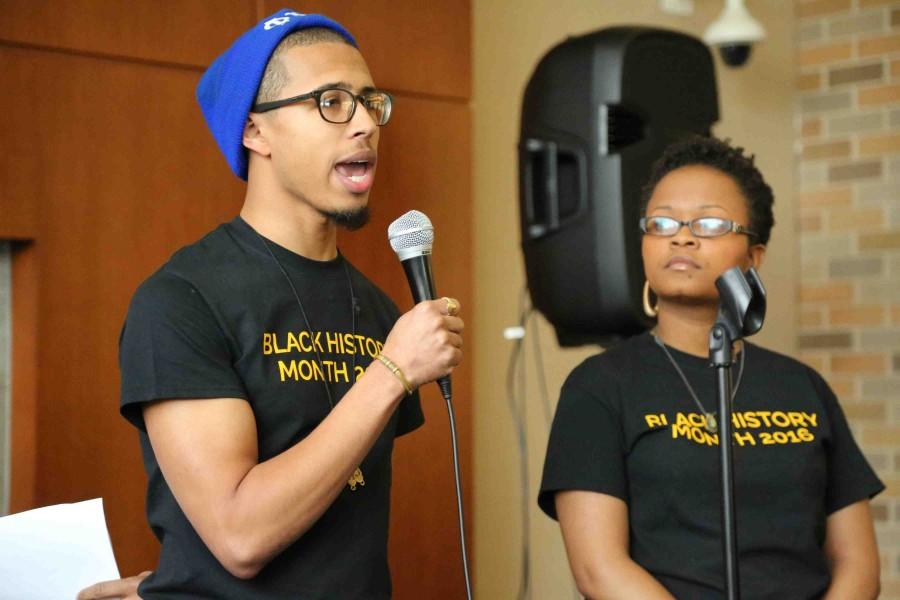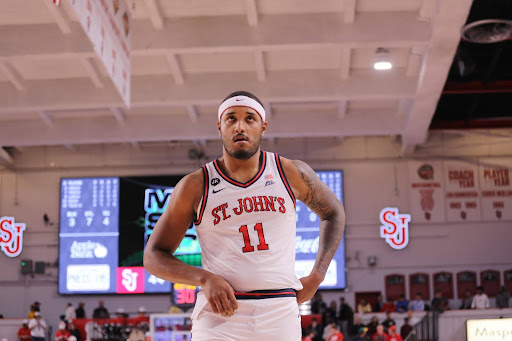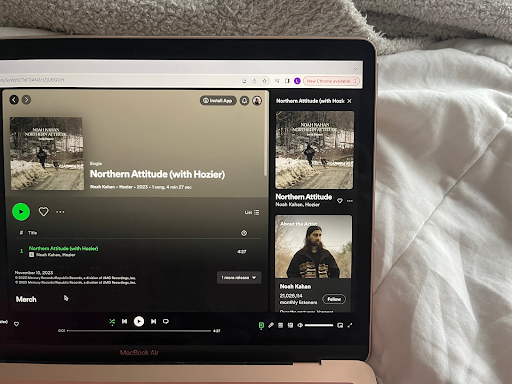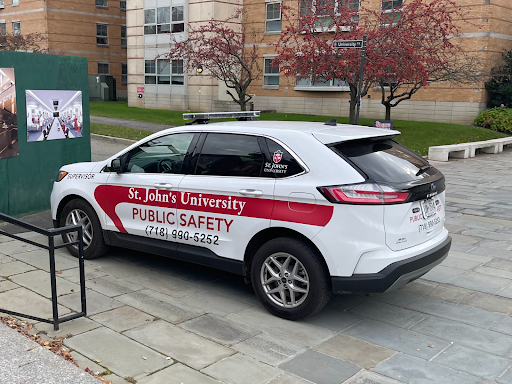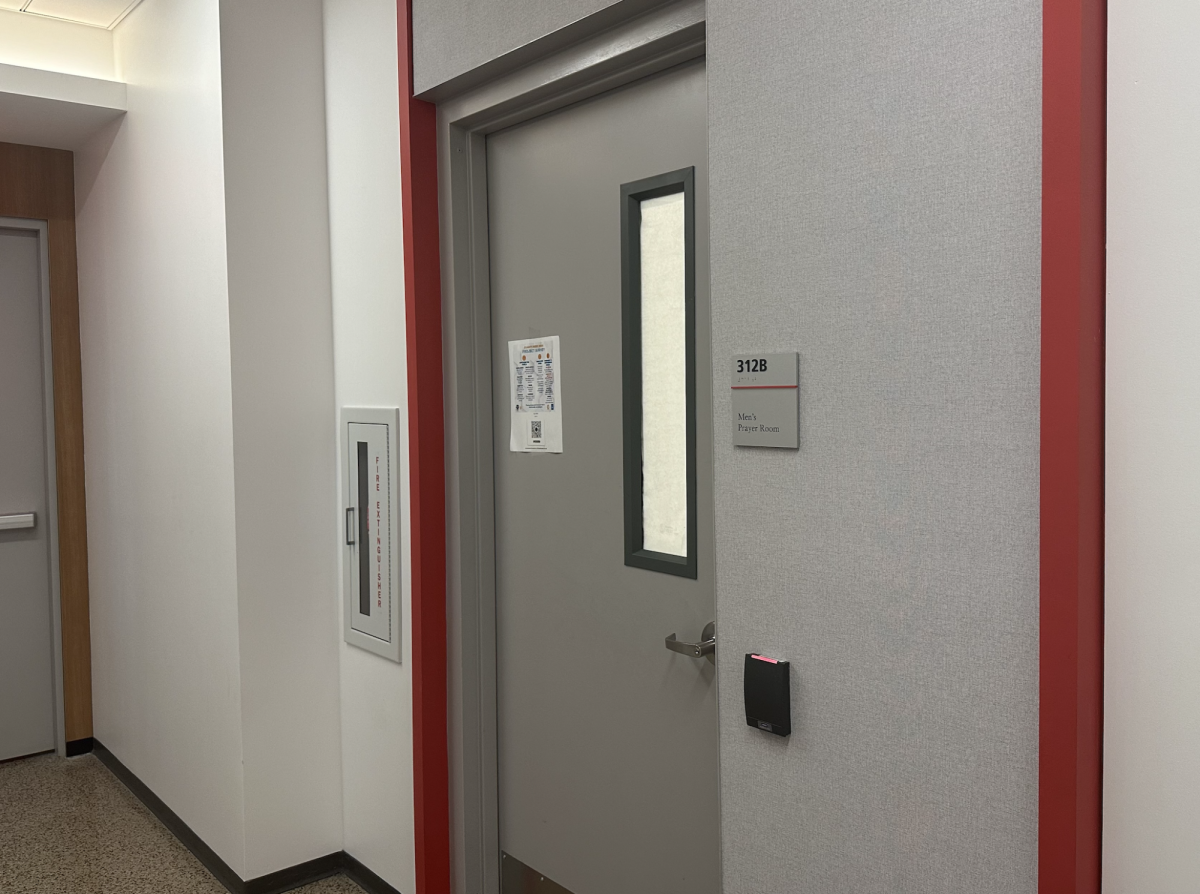More than 250 students gathered in the D’Angelo Center on Feb. 10 and called for the University to take action to improve racial inequality.
The demonstration, organized by a group of students, faculty, administration and alumni that call themselves the Students of Consciousness, was planned on Feb. 8 following an outcry in the comments section on the St. John’s University Instagram page.
On a post acknowledging Lunar New Year, alumnus Xavier Buck commented about the lack of any mention of Black History Month events. When someone else replied, “that’s because no one cares,” more than 300 others replied, “I care,” in the comments section.
That exchange sparked this student-led movement seeking better awareness of an array of issues raised by the Students of Consciousness.
According to Buck, who also spoke at the demonstration, Black History Month events at St. John’s began at the end of January.
“The thing is that we were eight days into Black History Month, not to mention that Black History Month for us at St. John’s started a week prior to February,” Buck said in an interview with the Torch. “So we were really over two weeks into [Black History Month], and nothing had been said.”
Black History Month events at St. John’s started on January 26.
The Office of Marketing and Communications told the Torch, “We apologize, we can do better and we will. Black History Month is an important celebration and will continue to be highlighted throughout the month.”
University spokeswoman Elizabeth Reilly said that the Office has recently acquired both the Instagram and Twitter accounts for the University, and that they are still building their social media strategy. Reilly said the Office had been tweeting and retweeting about Black History Month since the beginning of February.
The Torch found that St. John’s University Student Life did make a post celebrating Black History Month on Feb.1 and that SJUNOW posted a similar tweet on the same day, though St. John’s University Instagram and Facebook profiles did not post about it until Feb. 8 and 10, respectively.
Senior Crystal Fomba believes the incident on Instagram sparked a recurring issue on campus regarding students.
“I feel like we do have an air of unfairness and [misrepresentation] at St. John’s University, especially for minority students, especially black and Latino individuals,” she said. “So the incident that happened on Instagram really just put it into such a broad light.”
At the demonstration, students introduced a list of nine demands to solve racial inequality and microaggressions involving the St. John’s black and Latino community. While the demands were formulated in two days, Buck notes that the list is a culmination of experiences throughout the years.
“These demands didn’t just spur in two days, although they were created in two days, it’s all from past things that have happened: collective experiences, past movements,” he said.
The list of nine demands called on the University to advertise Black History Month and Latino History Month events on all St. John’s social media outlets; to send a mass email to students to raise awareness; to employ four full time professors of color in the history, sociology, psychology and English departments who specialize in Africana studies; and to create a MySJU online form for students to report on any microaggression experiences on campus; amongst others.
At the demonstration, Buck stated the percentage of black and Latino professors compared to faculty of white descent.
“This demonstration is because only 4.1 percent of full-time faculty members are black, and only 4.9 percent of full-time faculty are Latino. This demonstration is because only seven percent of part time-time faculty are black, and only seven percent of part-time faculty are Latino. This demonstration is because 75 percent of both fulltime and part-time faculty are white,” he said.
According to fourth-year Tobin College of Business student Anscia Brown, who also spoke at the demonstration, all statistics were acquired through the Office of Institutional Research on the St. John’s University website.
Sophomore Amanda Espinao agreed with these numbers, as she recognized the lack of black and Latino professors teaching her classes.
“I haven’t had even one black or Latino teacher since I’ve been here, and I’m a sophomore,” she said. “As my second semester as a sophomore, that says a lot.”
Senior and President of Student Government Incorporated (SGI) Ridge McKnight agreed with the demand to call for more black and Latino professors, especially with the University’s highly diverse student body.
“I think our administration, faculty and staff should kind of represent that a little bit more,” McKnight said.
For junior Inez Grullon, the demand on increasing funding for Latin American and Caribbean studies resonated with her the most.
“We spend so much money here on tuition, trying to learn about the history that is going to be a part of our history,” she said. “It’s a demand to learn it.”
While students believe the demonstration served as the beginning of a movement, some understand there is still a long way to go until change can be implemented.
“I think we still have a long way to go, but we’re definitely going in the right direction,” junior Nic Mays said.
“There’s going to have to be more meetings, more talks, more demonstrations, more actual meetings with people in power to make these changes at the university,” Fomba said. “So, I think it starts today but it doesn’t end today.”
Buck and Brown confirmed that a meeting with administration took place after the demonstration on Feb.10, but declined to disclose any information about the topics discussed during the meeting or which administrators were in attendance.
In response to the Students of Consciousness’ demonstration and list of demands, the University said in a statement, “The University takes the concerns of each of our students with great consideration and makes every effort to address those concerns so that all members of our community are valued and respected. As a Catholic and Vincentian institution, St. John’s encourages healthy dialogue and celebrates the varying traditions that our diverse student body brings to our university.”
During the demonstration, presidents and members of black and Latino organizations spoke on the impact students have on the St. John’s community.
President of African Students Association Oderah Obukwelu reminded students what these voices and demands could mean for future generations.
“These demands that we’re reading, they’re not going to be implemented next week, probably not next month, but the reason why these should be implemented is for the people after us,” he said. “For those freshman, those sophomores, those juniors, those young students who are really trying to make a difference.”
In order to document the types of experiences faced on campus, students took to Twitter to state and describe their concerns that relate to the demands, using the hashtag #SJUDemands.
“Why are all my classes about Black people taught by white people? How can a white person teach me about my own experience? #SJUDemands,” tweeted one student, Jason Ajiake.
Another student, senior Dylan Legarda, tweeted, “#SJUDemands is not about free college or ‘gifts’, it is about SJU embracing its diverse student body instead of using them as marketing tools.”
Students were encouraged to sign an online petition form supporting the demands formulated by a group of students. While it generated over 250 signatures, the petition was closed early because it received hate speech, according to Buck.
Once the demonstration was over, Post-it notes were passed around for students to write their concerns.
“I wrote for the black community to become more predominant on our campus,” said junior Devin Mims.
More than 75 Post-its were presented on a window in DAC, forming the words, “I Care,” the same words used in support of black and Latino acknowledgement during the Instagram incident on Feb. 8.
Brown believes the movement will cultivate and develop until the demands are carried out.
“It’s a student-led movement that will continue to grow and continue to hold events until our demands have been fulfilled,” she said in an interview with the Torch. “They are not just requests, they are demands that we are asking from the University, and that’s the least they can do.”
Buck agrees, and believes that while Black History Month is a time to admire, changes will continue past February.
“This is a movement, and just how black history is 12 months out of the year, Black History Month is a moment where we can celebrate, but we’re continuing this past February,” he said. “This will be dealt with the entire year until our demands are met.”
Additional reporting by Talia Tirella, Kyle Fitzgerald and Suzanne Ciechalski.


